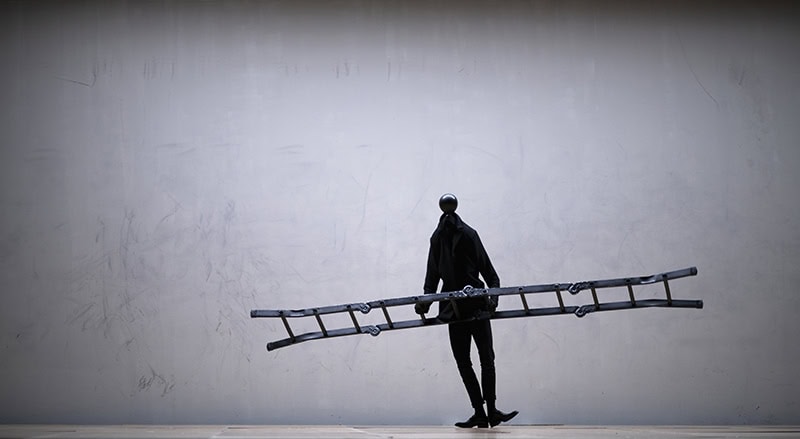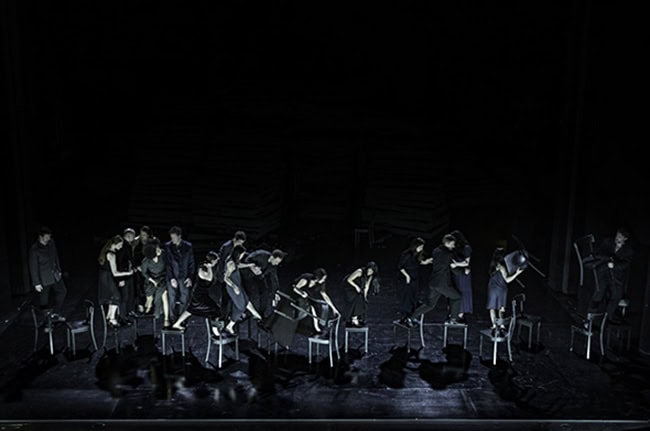Dance Umbrella 2021: Dimitris Papaioannou’s Transverse Orientation
Posted: October 30th, 2021 | Author: Nicholas Minns | Filed under: Performance | Tags: Aggelos Mendis, Breanna O'Mara, Dance Umbrella 2021, Dimitris Korres, Dimitris Papaioannou, Loukas Bakas, Nectarios Dionysatos, Stephanos Droussiotis, Tina Papanikolaiou, Tina Tzoka | Comments Off on Dance Umbrella 2021: Dimitris Papaioannou’s Transverse OrientationDimitris Papaioannou, Transverse Orientation, Sadler’s Wells, October 21

Dimitris Papaioannou, whose new production, Transverse Orientation, was presented at Sadler’s Wells as part of Dance Umbrella 2021, might well agree with the late photographer Manuel Alvarez Bravo who noted that, “Down here everything is symbol and mystery.” Papaioannou, who trained in the visual arts, has made his reputation by presenting symbols and mysteries for the three-dimensional stage. In addition to his 8 performers, he has an extraordinary team to help him, with set designers Tina Tzoka and Loukas Bakas, lighting designer Stephanos Droussiotis, costume designer Aggelos Mendis, props constructor Nectarios Dionysatos, and mechanical inventor Dimitris Korres. Dance Umbrella presented The Great Tamer in 2018, in which Papaioannou introduced a complex array of theatrical images that referenced a trajectory from Greece’s ancient heritage to NASA’s landing on the moon, harnessing his powerful graphical theatre to an overriding theme of cultural archaeology. Transverse Orientation anticipates a future archaeology by mapping the effect of human intervention on natural environments. The irony of the title, which refers to the nocturnal moth’s evolutionary method of travel, is that moths are notnaturally attracted to a bright light; they are deceived by it. Their evolved nocturnal navigation system is short-circuited by anything brighter than moonlight to the point of paralysis and potential death by predators.
Tzoka and Bakas present a bleak, almost two-dimensional stage with a long back wall, a fluorescent light fixture high on one side and a door flush with the wall on the other. The stillness is charged with dramatic possibility until the light crackles into action and the door opens to a small swarm of anonymous, two-legged arthropod figures in black carrying a ladder. Seen in silhouette, this ballet of frenzied walks and gestures is a masterpiece of comic exaggeration and surreal invention (one of the moths — Breanna O’Mara — returns later to do a rousing tap routine).
When Emma Gladstone asked Papaioannou in the post-show talk about his creative process he narrowed his response to describing the constraints of a deadline on both the period of creation and on the shaping and editing of the material into an integrated performance. But for someone like Papaioannou who delights in creating work as a palimpsest of imagery derived equally from ancient mythologies, renaissance art, and surrealism, the choice of what images to gather and how to place them in his theatrical universe must correspond at times to the attraction of moths to a bright light.
This is an essentially existential metaphor that could relate both to the creative process and to the ideas around which the images are circling. In the opening section of Transverse Orientation, Papaioannou illustrates this metaphor with sardonic wit, making us laugh with him as his moths teeter precariously around a light source that is subject to electrical and mechanical failure. But then he subjects us (literally) to a powerful, roving search light that temporarily blinds us, a theatrical sleight of hand introducing us to more familiar territory: a colossal bull tamed and nurtured by a naked man and giving birth to a woman who is then carried away naked on the bull’s back. While Papaioannou is not averse to reusing visual imagery from his creative storehouse, he uses it here under a different light. The young woman (O’Mara) may reference Europa whom Zeus, disguised as a bull, abducted to Crete, and the young woman in her dotage (Tina Papanikolaiou) returns movingly to see what has become of her namesake. While Europe may be at a critical juncture in its history, its political situation pales into insignificance in the face of the current climate emergency. Two further images link the allegory of the moths to Papaioannou’s depiction, in drawn-out theatrical time and space, of the current environmental crisis. The door in the back wall opens on to a solid wall of granite blocks. They begin to force their way through the door seemingly of their own volition, an interminable stream of earthquake debris along with the odd surviving body. The bodies then pile up the rubble on the side of the stage and leave it there, a mere inspiration for acrobatic games. In the final image the goddess of abundance tips her bucket of water on to the stage while slowly descending beneath it. More water is poured on to the stage while the performers rip up the floor sections and scatter them on either side. Standing in the water is a man with a bucket and mop, acutely aware of his own inadequacy.
What started off as parody has turned by degrees and digressions to darkest satire.
